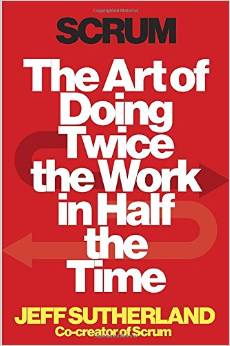 Scrum: The Art of Doing Twice the Work in Half the Time by Jeff Sutherland, Crown Business, New York, 2014.
Scrum: The Art of Doing Twice the Work in Half the Time by Jeff Sutherland, Crown Business, New York, 2014.
I am an absolute sucker for any book or article that tells me how to do more in less time. I’m a terrible timewaster/procrastinator/piddler. My mother used to say to me, “Debi, do you have to make such a project out of everything?” But here’s a book that sort of pushes the idea of making your life into a series of projects. It’s mainly directed to the business world, but, like the dinner book and the choosing college wisely book, there are wider implications to these ideas, and Sutherland acknowledges that fact. He includes a discussion of how Scrum would work for planning a wedding, but it would really work in any situation where you’re trying to get a specific task done or event carried out.
Sutherland originally came up with his ideas in connection with software development, an area about which I’m profoundly ignorant. But his point is, “The [old] process was slow, unpredictable, and often never resulted in a product that people wanted or would pay to buy. Delays of months or even years were endemic to the process. . . . almost without fail, we would fall quickly behind schedule and disastrously over budget” (vii). But this sort of thing happens all over the place. I would say that it’s especially true with groups that have regularly-scheduled meetings instead of meetings when needed and any time there’s one of those horrible “brainstorming” sessions. And of course any time you think you can put off planning and getting things done ahead. The essence of Scrum is that you do a chunk of the work, whatever it may be, and then step back and see how it works. You keep track of progress with some sort of physical tool, which for most Scrum teams in an office is a whiteboard with columns and sticky notes that move from “backlog” (all possible tasks) to “to do” (what really does need to be done) to “in progress” (actually being worked on) to “done” (done!). I’m not sure where I’d put a whiteboard with stickies in our house, but I’m seriously considering it. It’s a much more visually compelling tool than a to-do list scribbled in a planner or listed in a computer. There seems to be something very satisfying about just moving those pieces of paper from one column to the next–or even removing them when you realize that they’re unnecessary. The 80/20 rule is especially important to Scrum. Think about how many features of your various software programs you have on your computer that you actually use. It’s probably about 20%. None of us would or could actually eliminate 80% of the work in our lives, but it’s helpful to think in terms of what is really necessary. I know when I’m flying fast and low in a last-minute frenzy for some food event that I almost always eliminate at least one item, and we always have plenty of food. So maybe I should think in terms of eliminating the unnecessary ahead of time and avoid the stress of trying to do the undoable.